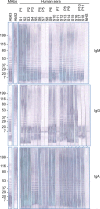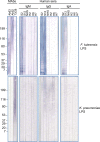Antibodies to both terminal and internal B-cell epitopes of Francisella tularensis O-polysaccharide produced by patients with tularemia
- PMID: 24351753
- PMCID: PMC3910946
- DOI: 10.1128/CVI.00626-13
Antibodies to both terminal and internal B-cell epitopes of Francisella tularensis O-polysaccharide produced by patients with tularemia
Abstract
Francisella tularensis, the Gram-negative bacterium that causes tularemia, is considered a potential bioterrorism threat due to its low infectivity dose and the high morbidity and mortality from respiratory disease. We previously characterized two mouse monoclonal antibodies (MAbs) specific for the O-polysaccharide (O antigen [OAg]) of F. tularensis lipopolysaccharide (LPS): Ab63, which targets a terminal epitope at the nonreducing end of OAg, and Ab52, which targets a repeating internal OAg epitope. These two MAbs were protective in a mouse model of respiratory tularemia. To determine whether these epitope types are also targeted by humans, we tested the ability of each of 18 blood serum samples from 11 tularemia patients to inhibit the binding of Ab63 or Ab52 to F. tularensis LPS in a competition enzyme-linked immunosorbent assay (ELISA). Although all serum samples had Ab63- and Ab52-inhibitory activities, the ratios of Ab63 to Ab52 inhibitory potencies varied 75-fold. However, the variation was only 2.3-fold for sequential serum samples from the same patient, indicating different distributions of terminal- versus internal-binding antibodies in different individuals. Western blot analysis using class-specific anti-human Ig secondary antibodies showed that both terminal- and internal-binding OAg antibodies were of the IgG, IgM, and IgA isotypes. These results support the use of a mouse model to discover protective B-cell epitopes for tularemia vaccines or prophylactic/therapeutic antibodies, and they present a general strategy for interrogating the antibody responses of patients and vaccinees to microbial carbohydrate epitopes that have been characterized in experimental animals.
Figures



Similar articles
-
The binding sites of monoclonal antibodies to the non-reducing end of Francisella tularensis O-antigen accommodate mainly the terminal saccharide.Immunology. 2013 Nov;140(3):374-89. doi: 10.1111/imm.12150. Immunology. 2013. PMID: 23844703 Free PMC article.
-
Protective B-cell epitopes of Francisella tularensis O-polysaccharide in a mouse model of respiratory tularaemia.Immunology. 2012 Jul;136(3):352-60. doi: 10.1111/j.1365-2567.2012.03589.x. Immunology. 2012. PMID: 22486311 Free PMC article.
-
Characterization of monoclonal antibodies to terminal and internal O-antigen epitopes of Francisella tularensis lipopolysaccharide.Hybridoma (Larchmt). 2011 Feb;30(1):19-28. doi: 10.1089/hyb.2010.0083. Hybridoma (Larchmt). 2011. PMID: 21466282 Free PMC article.
-
Nature of protective immunity to Francisella tularensis.Rev Infect Dis. 1989 May-Jun;11(3):440-51. Rev Infect Dis. 1989. PMID: 2665002 Review.
-
Innate and adaptive immune responses to an intracellular bacterium, Francisella tularensis live vaccine strain.Microbes Infect. 2003 Feb;5(2):135-42. doi: 10.1016/s1286-4579(02)00084-9. Microbes Infect. 2003. PMID: 12650771 Review.
Cited by
-
Aerosol prime-boost vaccination provides strong protection in outbred rabbits against virulent type A Francisella tularensis.PLoS One. 2018 Oct 22;13(10):e0205928. doi: 10.1371/journal.pone.0205928. eCollection 2018. PLoS One. 2018. PMID: 30346998 Free PMC article.
-
Francisella tularensis Vaccines Elicit Concurrent Protective T- and B-Cell Immune Responses in BALB/cByJ Mice.PLoS One. 2015 May 14;10(5):e0126570. doi: 10.1371/journal.pone.0126570. eCollection 2015. PLoS One. 2015. PMID: 25973794 Free PMC article.
-
Development of Immunoassays for Detection of Francisella tularensis Lipopolysaccharide in Tularemia Patient Samples.Pathogens. 2021 Jul 22;10(8):924. doi: 10.3390/pathogens10080924. Pathogens. 2021. PMID: 34451388 Free PMC article.
-
Monophosphoryl Lipid A Enhances Efficacy of a Francisella tularensis LVS-Catanionic Nanoparticle Subunit Vaccine against F. tularensis Schu S4 Challenge by Augmenting both Humoral and Cellular Immunity.Clin Vaccine Immunol. 2017 Mar 6;24(3):e00574-16. doi: 10.1128/CVI.00574-16. Print 2017 Mar. Clin Vaccine Immunol. 2017. PMID: 28077440 Free PMC article.
-
Discovery of protective B-cell epitopes for development of antimicrobial vaccines and antibody therapeutics.Immunology. 2014 May;142(1):1-23. doi: 10.1111/imm.12213. Immunology. 2014. PMID: 24219801 Free PMC article. Review.
References
Publication types
MeSH terms
Substances
Grants and funding
LinkOut - more resources
Full Text Sources
Other Literature Sources
Molecular Biology Databases
Miscellaneous

